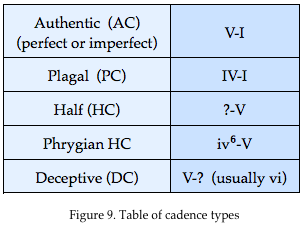To indicate the similarity of the phrases, it is customary to label them a and a'. If the phrase beginnings are not similar, but the phrases still have an antecedent-consequent relationship, they form a contrasting period (labeled a b).

The effect of an "open" ending and a "closed" one is produced by the cadence at the end of each phrase. A cadence is a real or implied chord change that provides a kind of harmonic punctuation at a phrase ending, just as a comma or period can end a phrase in verbal language.
The V-I cadence, called the authentic cadence, could be likened to a period at the end of a sentence; it sounds like a conclusion. A perfect authentic cadence, abbreviated PAC, is one that ends with the tonic note in the upper voice, with both the V and I chords in root position. The final phrase of a period almost always ends with a PAC. An imperfect authentic cadence has the 3rd or 5th in the upper voice and it is not as conclusive as the PAC.
The first phrase of the Brahms example ended on a movement to V. This is called a half cadence - it seems to leave us waiting for something else to happen. You might liken it to this: the colon. See if you can hear the difference between the half cadence (HC) and the PAC in the example below: